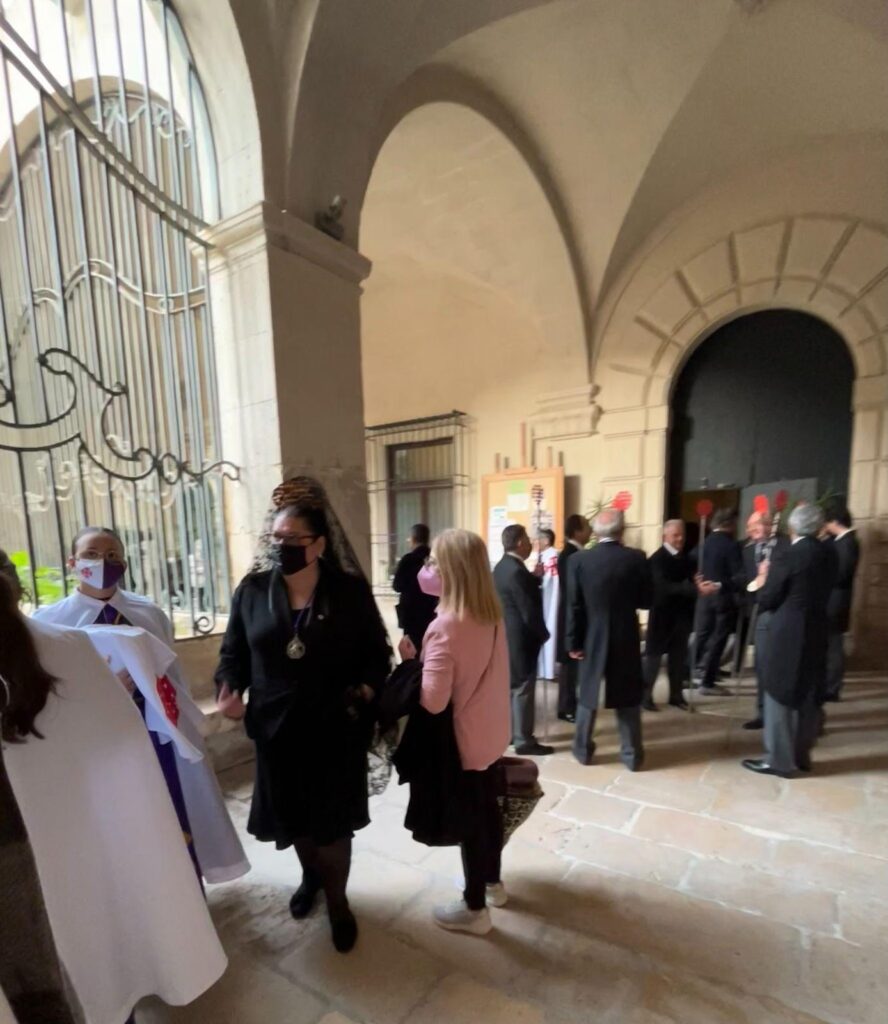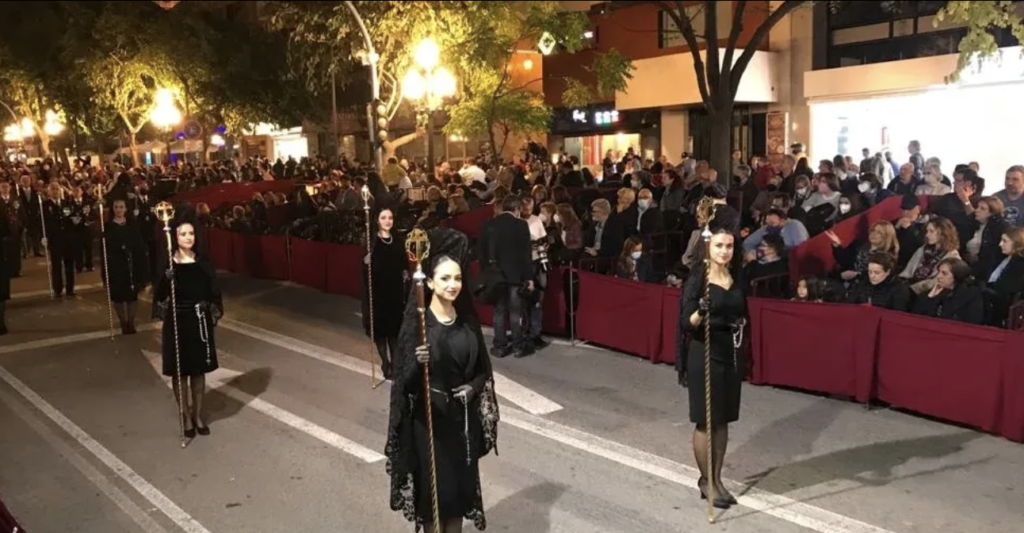Essay and photos by Daniela Lopez
ALICANTE, Spain–It’s 6:48 p.m. on Viernes Santo and the streets start to come alive. The main roads are closed and its edges are lined with thousands of chairs to accommodate the VIP guests, including the grandmas and grandpas who have saved their spot for the procession since 5 p.m. The streets and churches are decorated with red velvet fabrics. I asked one of the grandmas sitting close by if there is any symbolism behind this choice of color. “Pues hija, por la sangre de Cristo,” she said with a smile. Red represents the blood of Christ and his martyrdom, which is why the color is largely used in Viernes Santo, the day Cristo died.

As I continue my stroll, the rest of the spectators create a sea of people on the sidewalks, and kids are lifted onto their parents’ shoulders for the best views. The thousands of eyes await the Semana Santa tradition that has been part of their culture since the 15th Century.
Also all around town, the penitentes are getting ready and frantically running somewhere, their capes and gowns flowing behind them. I decide to follow some of them through the crowded streets and end up inside the Santa Iglesia Concatedral de San Nicolás de Bari de Alicante.
In this grand cathedral built in 1616, some believers are praying silently and the pasos–the massive statuesque scenes of Cristo’s last days– are undergoing final preparations before being carried out of the cathedral. Loud laughter and chatter from behind the altar catch my attention. I was shocked. Back in Colombia, the temple is a quiet and somehow eerie place where we should be absolutely quiet and respectful. I thought my ears were lying to me, so I walked all the way to the front of the iglesia and found the doors next to the altar open. Should I go in? Since I was a kid I always wondered what was behind those mysterious doors. I went in and yet again, shock. The sacristy looked more like a dressing room than a temple. People walked freely through its corridors while getting ready. The aura was joyful and I sat in a pew in front of an altar to take it all in.

A child with a bowl cut who was not more than 6 years old sat next to me and prayed to the father Saint Nicholas statue. The massive, golden altarpiece stands before us, angels surrounding the saint and a crucified Jesus Christ on the top of it. The boy kneeled down and talked to the saint as if he were his best friend. I looked up to take in the rather unpleasant expression on the saint’s face, a cold gaze with half-open eyes and expressionless lips. When I was a kid I felt intimidated, if not scared, of this kind of statue, with its tears forever rolling down his face. But this child seemed so happy and comfortable. In that moment, I realized that the way I was “evangelized” was probably not one of love for God, but fear of him. Soon after, the boy’s mother came for him. She was dressed in all black with a beautiful black mantilla placed atop a tall peineta, or decorative comb, in her hair.
The few women I saw participating in the celebrations were dressed this same way, with their veils, medium-length black dresses, black nylons, and black shoes, some with high heels. Even today there are brotherhoods that limit the participation of women as penitentes in the processions. Traditionally, the only representation of women during Semana Santa involves slow walking women in black mantillas and a dedication to embroidery of nazareno habits. However, little by little, women have been joining the ranks of Nazarenes, their work has been officially recognized, and they are part of boards and musical bands that lead or follow the massive pasos.

I asked one of the women why they dressed in all black when others wore robes of purple, white, red, and she answered: “Porque hoy es el día que murió el Señor; hay que estar de luto.” She was in her early 20s and the mantilla she wore, a traditional Spanish black veil worn on women’s heads and shoulders, had been passed down by the women in her family for three generations. In our short conversation, she mentioned that women started to participate in the procession for the first time in the 1960s. She said that her grandmother taught her how to walk and she will do the same with young women carrying the traditions into the future.
I don’t consider myself a religious person, nevertheless I admire the spirituality and tradition of Semana Santa. While sharing this point of view with one of the abuelas, she interrupted me and said: “No vale nada, hija. Paz es lo que necesitamos. En estos días de Semana Santa resucitemos la fe y esperanza porque eso nos ayudará a encontrar la paz que tanto necesitamos despues estos años tan dificiles.”
